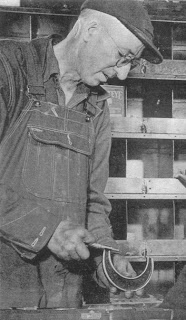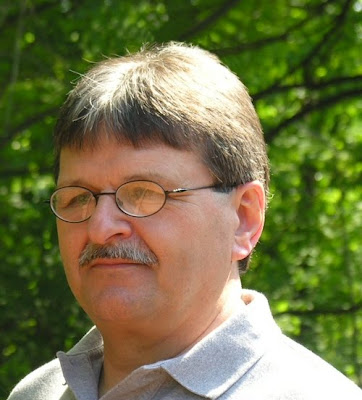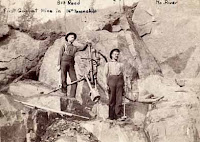 I recently covered some pretty tough hombres from Lyon Mountain in far upstate New York. Rugged folks, for sure, but by no means had they cornered the market on regional toughness. Here are a few of my favorite stories of Adirondack and North Country resilience. Read more
I recently covered some pretty tough hombres from Lyon Mountain in far upstate New York. Rugged folks, for sure, but by no means had they cornered the market on regional toughness. Here are a few of my favorite stories of Adirondack and North Country resilience. Read more
Mining
Swedish Lyon Mountain Mining Oral History
 Last week’s subject, iron miner George Davies (1892–1983) of Standish and Lyon Mountain, was a kindly gentleman with a powerful work ethic and a can-do, pioneer spirit. Interviews with him in 1981 were key to my second book, Lyon Mountain: The Tragedy of a Mining Town. Humble and matter of fact, he shared recollections from nearly 80 years earlier. Read more
Last week’s subject, iron miner George Davies (1892–1983) of Standish and Lyon Mountain, was a kindly gentleman with a powerful work ethic and a can-do, pioneer spirit. Interviews with him in 1981 were key to my second book, Lyon Mountain: The Tragedy of a Mining Town. Humble and matter of fact, he shared recollections from nearly 80 years earlier. Read more
Lyon Mountain Mines: George Davies of Clinton County

George Davies of Standish in Clinton County was about as tough an Adirondacker as you’ll find anywhere. Standish was the sister community to Lyon Mountain during its century-long run of producing the world’s best iron ore. Davies (1892–1983) was among the many old-timers I interviewed around 1980 for my second book, Lyon Mountain: The Tragedy of a Mining Town. He was kind, welcoming, and honest in describing events of long ago.
George was a good man. The stories he told me seemed far-fetched at first, but follow-up research in microfilm archives left me amazed at his accuracy recounting events of the early 1900s. His truthfulness was confirmed in articles on items like strikes, riots, injuries, and deaths.
When I last interviewed George in 1981 (he was 88), he proudly showed me a photograph of himself as Machine Shop Supervisor in the iron mines, accepting a prestigious award for safety. I laughed so hard I almost cried as he described the scene. George, you see, had to hold the award just so, hiding the fact that he had far fewer than his originally allotted ten fingers. He figured it wouldn’t look right to reveal his stubs while cradling a safety plaque.
In matter-of-fact fashion, he proceeded to tell me what happened. Taken from the book, here are snippets from our conversation as recorded in 1981: “I lost one full finger and half of another in a machine, but I still took my early March trapping run to the Springs. I had a camp six miles up the Owl’s Head Road. While I was out there, I slipped in the water and nearly froze the hand. I had to remove the bandages to thaw out my hand, and I was all alone, of course. It was just something I had to do to survive.
“When I lost the end of my second finger in an accident at work, I was back on the job in forty-five minutes. Another time I was hit on the head by a lever on a crane. It knocked me senseless for ten minutes. When I woke up, I went back to work within a few minutes. [George also pointed out that, in those days, there was no sick time, no vacation time, and no holidays. Unionization was still three decades away, and the furnace’s schedule ran around the clock.]
“When I started working down here, the work day was twelve hours per day, seven days a week, and the pay was $1.80 per day for twelve hours [fifteen cents per hour] around the year 1910. That was poor money back then. When they gave you a raise, it was only one or two cents an hour, and they didn’t give them very often.
“In one month of January I had thirty-nine of the twelve-hour shifts. You had to work thirty-six hours to put an extra shift in, and you still got the fourteen or fifteen cents per hour. It was pretty rough going, but everybody lived through it. Some people did all right back then. Of course, it wasn’t a dollar and a half for cigarettes back then [remember, this was recorded in 1981].
“Two fellows took sick at the same time, two engineers that ran the switches. They sent me out to work, and I worked sixty hours without coming home. Then the boss came out to run it and I went and slept for twelve hours. Then I returned for a thirty-six hour shift. No overtime pay, just the rate of twenty-five cents per hour.” Now THAT’s Lyon Mountain toughness.
The tough man had also been a tough kid. “When I was thirteen years old, I worked cleaning bricks from the kilns at one dollar for one thousand. On July 3rd, 1907, when I was fifteen, I accidentally shot myself in the leg. I stayed in Standish that night, and on the next day I walked to Lyon Mountain, about three miles of rough walking.”
His father was in charge of repairing the trains, and young George climbed aboard as often as he could. “I was running those engines when I was sixteen years old, all alone, and I didn’t even have a fireman. I always wanted to be on the railroad, but I had the pleasure of losing an eye when I was nine years old. I was chopping wood and a stick flew up and hit me in the eye.
“I pulled it out, and I could see all right for a while. Not long after, I lost sight in it. The stick had cut the eyeball and the pupil, and a cataract or something ruined my eye. The doctor wanted to take the eye out, but I’ve still got it. And that’s what kept me off of the railroad. That was seventy-nine years ago, in 1901.”
Next week: A few of George Davies’ remarkable acquaintances.
Photo: George Davies.
Lawrence Gooley has authored 11 books and more than 100 articles on the North Country’s past. He and his partner, Jill McKee, founded Bloated Toe Enterprises in 2004. Expanding their services in 2008, they have produced 32 titles to date, and are now offering web design. For information on book publishing, visit Bloated Toe Publishing
New Contributor:North Country Historian Lawrence Gooley
 Please join me in welcoming New York History‘-s newest contributor, Lawrence Gooley of Clinton County. Gooley is an award-winning author who has hiked, bushwhacked, climbed, bicycled, explored, and canoed in the Adirondack Mountains for 40 years. With a lifetime love of research, writing, and history, he has authored eight books and several articles on the region’s past, and in 2009 organized the North Country Authors in the Plattsburgh area. His book Oliver’s War: An Adirondack Rebel Battles the Rockefeller Fortune won the Adirondack Literary Award for Best Book of Nonfiction in 2008. His most recent effort is Terror in the Adirondacks: The True Story of Serial Killer Robert F. Garrow.
Please join me in welcoming New York History‘-s newest contributor, Lawrence Gooley of Clinton County. Gooley is an award-winning author who has hiked, bushwhacked, climbed, bicycled, explored, and canoed in the Adirondack Mountains for 40 years. With a lifetime love of research, writing, and history, he has authored eight books and several articles on the region’s past, and in 2009 organized the North Country Authors in the Plattsburgh area. His book Oliver’s War: An Adirondack Rebel Battles the Rockefeller Fortune won the Adirondack Literary Award for Best Book of Nonfiction in 2008. His most recent effort is Terror in the Adirondacks: The True Story of Serial Killer Robert F. Garrow.
Gooley’s fascination with area history serves his readers well and he’s not afraid to get away from his desk an onto the ground where that history happened. He once researched a brief history of each bay on the Lake Champlain shoreline for example, prepared it in a binder with protective plastic sheets, laid it open on the bench seat of his canoe, and “lived history” for a week while paddling from Whitehall to Plattsburgh.
Gooley is a strong supporter of the Lyon Mountain Mining & Railroad Museum, where a 6-foot-long wall plaque hangs with the names of 162 men who died in accidents in Lyon Mountain’s iron mines. The plaque is based on information from his book Out of the Darkness.
With his partner, Jill McKee, Gooley founded Bloated Toe Enterprises in 2004 and have recently begun to expand their services and publishing work. They especially enjoy helping organizations and new authors navigate all the pitfalls of getting their work published, and seeing authors earn profits from their books. Besides Bloated Toe Publishing, they also operate an online store to support the work of other regional folks. The North Country Store features more than 100 book titles and 60 CDs and DVDs, along with a variety of other area products.
Hook Mountain Saved 100 Years Ago
 One hundred years ago this month, less than a year after the Harriman gift of $1,000,000 and 10,000 acres was leveraged to raise an additional $4.5 million in private and state funds, the Palisades Interstate Park Commission began its purchase of the five quarries that were steadily eating away at the stately Hook Mountain ridge between Nyack and Haverstraw, New York.
One hundred years ago this month, less than a year after the Harriman gift of $1,000,000 and 10,000 acres was leveraged to raise an additional $4.5 million in private and state funds, the Palisades Interstate Park Commission began its purchase of the five quarries that were steadily eating away at the stately Hook Mountain ridge between Nyack and Haverstraw, New York.
The first quarry purchased belonged to the Manhattan Trap Rock Company. Its facilities, including the concrete power house used to crush the rock before being loaded onto barges from the wharf, were eventually dismantled or converted by the WPA to recreational facilities. The power house, a beautiful dutch colonial sandstone building that sits at the foot of the mountain, was transformed into a bath house when swimming in the Hudson was still permitted. This magnificent example of adaptive use is now experiencing a second wave of interest by the community as the anchor of Nyack Beach State Park.
The River Trail, one of the Hudson River Valley Greenway Trails, runs north from Nyack Beach for almost five miles. A magnet for runners, cyclists, bird watchers, fishermen, lovers, and artists, it is the only trail along the lower Hudson in New York that does not share its waterfront with a train line or highway. The Long Path parallels this trail high above atop the cliffs.
Adk Museum Receives NEH Planning Grant
 The Adirondack Museum at Blue Mountain Lake, New York has been awarded a grant in the amount of $40,000 by the National Endowment for the Humanities (NEH). The funds will be used in the planning and development phase of the museum’s new long-term exhibition “Mining in the Adirondacks,” scheduled to open in 2013.
The Adirondack Museum at Blue Mountain Lake, New York has been awarded a grant in the amount of $40,000 by the National Endowment for the Humanities (NEH). The funds will be used in the planning and development phase of the museum’s new long-term exhibition “Mining in the Adirondacks,” scheduled to open in 2013.
NEH has designated the Adirondack mining exhibit a National Endowment for the Humanities “We the People” project. Support comes in part from funds the agency has set aside for this special initiative.
The goal of the “We the People” initiative is to encourage and strengthen the teaching, study, and understanding of American history and culture through the support of projects that explore significant events and themes in our nations history and culture, and advance knowledge of the principles that define America.
The National Endowment for the Humanities is an independent federal agency created in 1965. It is one of the largest funders of humanities programs in the United States.
The Endowment accomplishes its mission by providing grants for high-quality humanities projects in four funding areas: preserving and providing access to cultural resources, education, research, and public programs.
NEH grants typically go to cultural institutions such as museums, archives, libraries, colleges, universities, public television and radio stations, and to individual scholars.
Photo: Garnet miners at Barton Mines, North River, N.Y.: ca. 1915.
Adk Museum Presents The Adirondack Mining Village
 Mining was once a major industry in northern New York State. Small iron mines and forges appeared along Lake Champlain in the late 1700s. In the 1820s, the industry began to grow rapidly, reaching its peak in the mid-to-late 1800s. The story of mining is much more than minerals found and ores extracted. This Monday, July 13, 2009 Dr. Carol Burke will explore human aspects of Adirondack mining in an illustrated program entitled “The Adirondack Mining Village” at the Adirondack Museum at Blue Mountain Lake, New York.
Mining was once a major industry in northern New York State. Small iron mines and forges appeared along Lake Champlain in the late 1700s. In the 1820s, the industry began to grow rapidly, reaching its peak in the mid-to-late 1800s. The story of mining is much more than minerals found and ores extracted. This Monday, July 13, 2009 Dr. Carol Burke will explore human aspects of Adirondack mining in an illustrated program entitled “The Adirondack Mining Village” at the Adirondack Museum at Blue Mountain Lake, New York.
Part of the museum’s popular Monday Evening Lecture series, the presentation will be held in the Auditorium at 7:30 p.m. There is no charge for museum members. Admission is $5.00 for non-members.
Burke’s presentation reflects an ongoing project that documents accounts of the daily lives or ordinary people who lived and worked in the now abandoned mining villages of Tahawus and nearby Adirondac (known in the 1950s as “The Upper Works”). Dr. Burke will share photographs and recollections of everyday life in these former company towns.
Carol Burke, a Professor at the University of California at Irvine, is a folklorist and journalist whose ethnographic work has produced books that document the lives of Midwestern farm families, female inmates in our nation’s prisons, and most recently, members of the armed services. Six months ago she was embedded with an army unit in northern Iraq.
Dr. Burke spends her summers in the Adirondacks and is currently documenting the everyday life of the once-flourishing mining village of Tahawus. Before joining the faculty at the University of California at Irvine, Professor Burke taught at Vanderbilt University, Johns Hopkins University, and the United States Naval Academy.
The broad story of mining in the Adirondacks is one of fortunes made and lost, of suicide, madness, and ambition, and the opening of one of America’s last frontiers. Mining shaped the physical and cultural landscape of the Adirondack Park for generations. The Adirondack Museum plans to open the completely revitalized exhibit “Mining in the Adirondacks” in 2012 to share this incredible history.
Photo: Adirondack Village, Near the Upper Works. From Benson J. Lossing’s The Hudson, from the Wilderness to the Sea, 1859.
Songs and Stories of Adirondack Lumberjacks and Miners
 Begin the New Year with an afternoon of engaging tunes and tales. Join the staff of the Adirondack Museum for “Working for the Man: Songs and Stories of Adirondack Lumberjacks and Miners.” The special program will be held at the Tannery Pond Community Center in North Creek, (Warren County) on Sunday, January 10, 2010 at 3:30 p.m. There will be no charge for museum members and children of elementary school age or younger. The fee for non-members is $5.00.
Begin the New Year with an afternoon of engaging tunes and tales. Join the staff of the Adirondack Museum for “Working for the Man: Songs and Stories of Adirondack Lumberjacks and Miners.” The special program will be held at the Tannery Pond Community Center in North Creek, (Warren County) on Sunday, January 10, 2010 at 3:30 p.m. There will be no charge for museum members and children of elementary school age or younger. The fee for non-members is $5.00.
The historic work of loggers and miners was framed by dangerous conditions, back breaking work, long hours, and low pay. Although daily life was hard and often heartbreaking, it was also filled with music, laughter, stories, and strong community ties.
“Working for the Man” will feature musician Lee Knight singing traditional ballads of logging, mining, and rural life. Museum Educator Christine Campeau will join Knight to share historic photographs, artifacts from museum collections, and stories of work, family, and life in Adirondack logging and mining communities.
Born in the Adirondacks, Lee Knight now lives in Cashiers, North Carolina. He is a singer, storyteller, song collector, and teacher of folklore, folk life, and folk music. He performs regularly at concerts, folk festivals, and summer camps, where he tells stories, sings ballads, and calls dances. He has appeared with Pete Seeger, Jean Ritchie, Bill Monroe, Alan Lomax, and many others. He will play traditional hand-made instruments.
Following the program, Lee Knight will perform at the Copperfield Inn from 4:30 p.m. until 6:00 p.m. Extend the afternoon and make it a party! Join friends and neighbors to enjoy good music and sample food and drink specials offered by the Copperfield.
Photo: Ruby Mountain Mine, North River Garnet Company. Collection of the Adirondack Museum.